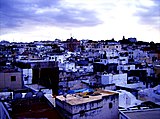Kasbah Palace, Tangier
Musée des Cultures Méditerranéennes | |
 Main courtyard of the Kasbah Palace | |
 | |
| Location | Tangier, Morocco |
|---|---|
| Coordinates | 35°47′19″N 5°48′46″W / 35.78861°N 5.81278°W |
| Type | art museum |
| Key holdings | Roman items, Carthaginian objects |
The Kasbah Palace, also known as Dar al-Makhzen, Sultan's Palace or Governor's Palace and formerly as the Sharifian Palace,[1]: 650 is a historical building and museum in the Kasbah or citadel of Tangier, Morocco. Its site has long been the main seat of political power in Tangier. The current structure was built in the early 18th century as the residence of the city's governor and home for the Sultan of Morocco when staying in the city, for example Hassan I in 1889. It has been repurposed as a museum since 1922, named the Kasbah Museum of Mediterranean Cultures since renovation in 2016,[2] with the Kasbah Museum Contemporary Art Space added in late 2021.[3]
History
[edit]The edifice was built during the reign of sultan Moulay Ismail in the early 18th century over the ruins of the English "Upper Castle".[1]: 650 It was constructed by Pasha Ahmad ben Ali al-Rifi, general of the Jaysh al-Rifi and semi-autonomous governor of Tangiers.[4]
In 1922,[2] French scholar Édouard Michaux-Bellaire initiated the structure's transformation into a museum.[5]: 14 It was comprehensively renovated in the early 2010s and reopened in 2016.[2]
Description
[edit]The building is situated in the eastern part of the Kasbah,[1]: 650 on one of the highest points of the city overlooking the medina and the Strait of Gibraltar. It is centered within two courtyards, which are decorated with wooden ceilings, marble fountains and arabesques. The elegant marble capitals of the columns in the main courtyard were most likely imported from Italy at the time of construction in the mid-18th century.[6]: 313 Dependencies facing the Kasbah's Mechouar include a former Bayt al-mal or treasury, created in the late 18th century,[5]: 10 and prisons.
Museum of Mediterranean Cultures
[edit]The former reception spaces and living quarters are now used by the Museum of Mediterranean Cultures (Musée des Cultures Méditerranéennes), displaying works of art from all over Morocco, amongst which are firearms decorated with marquetry, carpets, silks from Fez, and manuscripts. The Museum of Antiquities now occupies the former kitchen. It houses finds from ancient Roman sites as Lixus, Cotta and Volubilis, as well as a life-size Carthaginian tomb and finds from the Tangier region from prehistory until the Middle Ages.[7]
The museum's Contemporary Art Space opened in late 2021 in the palace's former prison facing the Mechouar,[3] which had remained in use until the early 1970s.[8]
Gallery
[edit]-
Former tribunal (left) and treasury (right) outside the Kasbah Palace
-
Museum entrance
-
Roman mosaic
-
Doorway
-
Wooden ceiling
-
Palace garden
See also
[edit]Notes
[edit]- ^ a b c Lévi-Provençal, Évariste (1936), "Tangier", in Martin Theodoor Houtsma; Arent Jan Wensinck; Hamilton Alexander Rosskeen Gibb; Wilhelm Heffening; Évariste Lévi-Provençal (eds.), Encyclopaedia of Islam, vol. IV, Leiden: E.J. Brill, pp. 650–652. For more up-to-date extensive coverage of the Tangier Kasbah, the Place de la Kasbah specifically, the Dar al-Makhzen zone, Dar Zero, and other adjacent features in this area, see for instance Martin Malcolm Elbl, Portuguese Tangier (1471–1662): Colonial Urban Fabric as Cross-Cultural Skeleton (Toronto / Peterborough: Baywolf Press, 2013), preceding publications and data such as Martin Malcolm Elbl, "Tangier's Qasba Before the Trace Italienne Citadel of 1558–1566: The 'Virtual' Archaeology of a Vanished Islamic and Portuguese Fortress," Portuguese Studies Review 17 (2) (2009): 1-45, and various subsequent publications, such as Martin Malcolm Elbl, "Tangier’s Domus Praefecti (Governor’s House) and Ceuta’s Paços Reais / Paço Velho (Palacio Viejo): 3D-Modelling Vanished Prestige Dwellings and Cross-Cultural Symbols of Governance," in Martin Malcolm Elbl, ed., Encounters in Borderlands: Portugal, Ceuta, and the 'Other Shore' (Toronto / Peterborough: Baywolf Press, 2019), 177–242, or most recently, Martin Malcolm Elbl, “ ‘Tunnels Below’ (Dar Zero ~ Tangier): Urban Myths, a German ‘Baron’ from Maryland, and a Very Real Portuguese Citadel," Portuguese Studies Review 30 (1) (2022): 199-239. The publications (in English) supply abundant references to secondary sources in English, Portuguese, French, and other languages, references to archival documents and primary sources, and references to indispensable graduate theses by diverse scholars. Transcripts of unpublished documents are available in these works, as are many maps, diagrams, and photographs. The large body of data entirely supersedes the 1936 "Tangier" article, clarifies the 'Upper Castle' issue, and addresses numerous other relevant points, setting the Kasbah Palace in very detailed long-run context. Most of the relevant items are accessible on academia.edu (consulted 29 May 2023). See https://utoronto.academia.edu/MartinMalcolmElbl
- ^ a b c "Musée la Kasbah des cultures méditerranéennes de Tanger". Archnet.
- ^ a b Leila Benslimane (26 December 2021). "Tangier gets a new Museum of Contemporary Art". Morocco Jewish Times.
- ^ [1] Tangiers
- ^ a b Jean-François Clément (1996), "Tanger avant le statut international de 1923", Horizons Maghrébins – le droit à la mémoire, 31–32
- ^ Jordi Mas Garriga (2019), La transformación de la ciudad de Tánger durante el Periodo Diplomático (1777–1912) : Arquitectura y Urbanismo, Universitat Rovira i Virgili
- ^ "Museums of Morocco - Musées du Maroc". Archived from the original on 2014-10-04. Retrieved 2008-05-24.
- ^ R. K. Houdaïfa (10 January 2022). "Musée de la Kasbah: nouveau espace d'art contemporain à Tanger". Finances News Hebdo.









